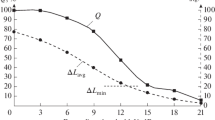Abstract
Manual visual inspection of the action rod of a rail switch machine is wasteful and incapable of detecting interior faults. As a result, this work describes an image quantitative detection approach for internal action rod flaws based on pulse reflection ultrasonic detection technology. First, the sound field properties are studied using simulation, and the best probe parameters are chosen. The rectangular and round rods’ signals are then acquired using circumferential scanning testing, and image reconstruction of the scanned data is performed based on the energy characteristics. Finally, the 8-neighborhood connection technique is developed to quantitatively assess the interior oblique fractures of the rectangular rod, with a relative length inaccuracy of less than 2.2%. In addition, the energy superposition method and polar image transformation are utilized to quantitatively examine the round rod’s interior hole flaws. The observed internal hole flaws have a relative error of diameter detection of less than 5% and a relative error of depth location in the radial direction of less than 3%.













Similar content being viewed by others
REFERENCES
Tao, T., Dong, D., Huang, S., et al., Gap detection of switch machines in complex environment based on object detection and image processing, J. Transp. Eng. A Syst., 2020, vol. 146, no. 8, p. 04020083.
Kaijuka, P.L., Dixon, R., Ward, C.P., et al., Model-based controller design for a lift-and-drop railway track switch actuator, IEEE/ASME Trans. Mechatronics, 2019, vol. 24, no. 5, pp. 2008–2018.
Sebès, M. and Bezin, Y., Considering the interaction of switch and stock rails in modelling vehicle-track interaction in a switch panel diverging route, Int. J. Veh. Mech. Mobility, 2022, vol. 61, no. 3, p. 765–781.
Yin, H., Liu, Z., Xu, Z., et al., An automatic visual monitoring system for expansion displacement of switch rail, IEEE Trans. Instrum. Meas., 2020, vol. 69, no. 6, pp. 3015–3025.
Pejkowski, U. and Seyda, J., Fatigue of four metallic materials under asynchronous loadings: Small flaws observation and fatigue life prediction, Int. J. Fatigue, 2021, vol. 142, p. 105904.
Li, H., Spencer, B.F., Liu, W., et al., Multi-feature integration and machine learning for guided wave structural health monitoring: Application to switch rail foot, Struct. Health Monit., 2021, vol. 20, no. 4, pp. 2013–2034.
Dutta, S., Harrison, T., Ward, C.P., et al., A new approach to railway track switch actuation: Dynamic simulation and control of a self-adjusting switch, Inst. Mech. Eng., 2019, vol. 234, no. 7, pp. 779–790.
Coleman, I., Kassa, E., and Smith, R., Wheel-rail contact modelling within switches and crossings, Int. J. Railway Technol., 2012, vol. 1, no. 2, pp. 45–66.
Yin, H., Liu, Z., Xu, Z., et al., An automatic visual monitoring system for expansion displacement of switch rail, IEEE Trans. Instrum. Meas., 2020, vol. 69, no. 6, pp. 3015–3025.
Bertovic, M., Fahlbruch, B., Müller, C., et al., Human factors approach to the acquisition and evaluation of NDT data, 18th WCNDT World Conf. Nondestr. Test. (Durban, 2012), pp. 1–10.
Bertovic, M., A human factors perspective on the use of automated aids in the evaluation of NDT data, AIP Conf. Proc., 2016, vol. 1706, p. 020003. https://doi.org/10.1063/1.4940449
Shin, S., Image preprocessing method in radiographic inspection for automatic detection of ship welding flaws, Appl. Sci., 2021, vol. 12, no. 1.
Hanke, R., Fuchs, T., and Uhlmann, N., X-ray based methods for non-destructive testing and material characterization, Nucl. Inst. & Methods Phys. Res. A, 2008, vol. 591, no. 1, pp. 14–18.
Abdalla, A.N., Faraj, M.A., Samsuri, F., et al., Challenges in improving the performance of eddy current testing, Meas. Control, 2019, vol. 52, nos. 1–2, pp. 46–64.
Xie, L., Gao, B., Tian, G.Y., et al., Coupling pulse eddy current sensor for deeper flaws NDT, Sens. Actuators A Phys., 2019, vol. 293, pp. 189–199.
Prada, C., Kerbrat, E., Cassereau, D., et al., Time reversal techniques in ultrasonic nondestructive testing of scattering media, Inverse Prob., 2002, vol. 18, no. 6, p. 1761.
Kim, Y.Y. and Kwon, Y.E., Review of magnetostrictive patch transducers and applications in ultrasonic nondestructive testing of waveguides, Ultrasonics, 2015, vol. 62, pp. 3–19.
Bombarda, D., Vitetta, G.M., and Ferrante, G., Rail diagnostics based on ultrasonic guided waves: an overview, Appl. Sci., 2021, vol. 11, no. 3, p. 1071.
Markov, A.A. and Maximova, E.A., Analyzing ultrasonic signal parameters during high-speed rail inspection, Russ. J. Nondestr. Test., 2021, vol. 57, pp. 181–194.
Liu, S.P., Liu, F.F., Shi, J.W., et al., High-resolution ultrasonic imaging evaluation and behavior analysis of impact damages in composites, J. Mech. Eng., 2013, vol. 49, no. 22, pp. 16–23.
Li, Y.Q. and Xia, M.Y., Time reversal imaging based on synchronism, IEEE Antennas Wireless Propag. Lett., 2017, vol. 16, pp. 2058–2061.
Ahmed, H. and Lee, J.R., Development of autonomous target recognition and scanning technology for pulse-echo ultrasonic propagation imager, Struct. Health Monit., 2020, vol. 19, no. 4, pp. 1064–1074.
Funding
This work was supported by Natural Science Research of Jiangsu Higher Education Institutions of China (22KJD140004).
Author information
Authors and Affiliations
Corresponding author
Ethics declarations
The authors declare that they have no conflicts of interest.
Rights and permissions
About this article
Cite this article
Jiang, Y., Han, L., Wang, R. et al. Quantitative Detection of Internal Flaws of Action Rod Based on Ultrasonic Technology. Russ J Nondestruct Test 59, 171–181 (2023). https://doi.org/10.1134/S1061830922601039
Received:
Revised:
Accepted:
Published:
Issue Date:
DOI: https://doi.org/10.1134/S1061830922601039




